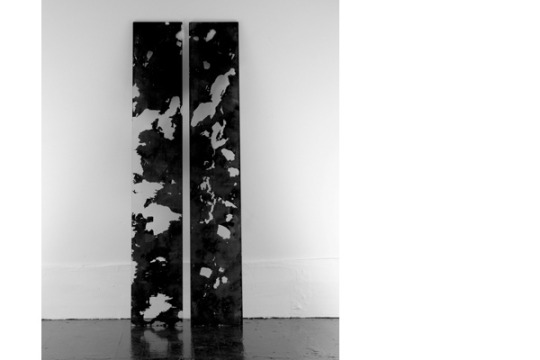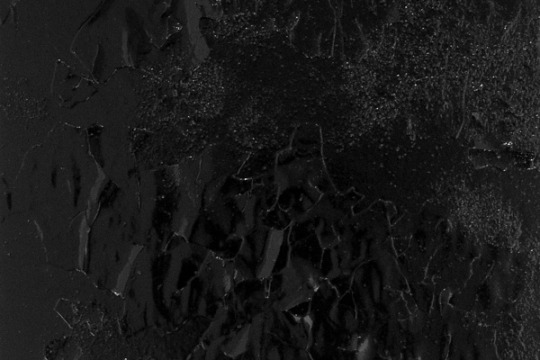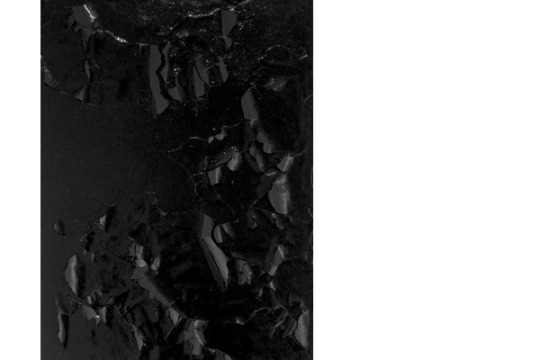Interview: Dennis Hoekstra

On the eve of the closing of his show “An Alias and a Taste for Togetherness” , we spoke with artist Dennis Hoekstra about his experience creating works for his latest show in San Francisco. The show was comprised of sculptures, paintings, and custom pigment prints. Across these media, Hoekstra investigates textures and materials that denote social class, urban decay, time, and generational modifications.
Walk us through your latest exhibition
The show included various paintings, sculptures, and prints. All the works were focused on recreating various types of material decay over time using man-made theatrical painting techniques. I showed five custom pigments prints with enamel, two glass panel sculptures with enamel, two foam block sculptures with joint compound and enamel, five “peeling-paint” pieces on wood panel with rosin paper and enamel, three “orange-peel” pieces on wood panel with joint compound and enamel and a “chipped paint” diptych on wood panel with joint compound, fiberglass and enamel.
What is the background on these pieces?
The works were created in winter/spring 2010, and were the result of several experiments in my studio during 2009. I had been working on several large-scale pieces during 2009 on sheet metal and installation wall paintings. After working on a rather dramatic theatrical scale, I wanted to use similar techniques on more modular panels in a much more relatable human scale.
How did the choice of materials fit into your choice of design?
All of the materials were chosen for their ability to create or mimic surfaces without being the actual surface itself, all with the exception of the final layer, which was oil-based enamel paint. Each texture recreates a different type of decay or build-up of that final surface: enamel paint. For the “peeling-paint” pieces, the surfaces recreate paint that has been applied over and over, even after peeling as the result of water damage. The “orange-peel” pieces recreate enamel that has been applied simply and perfectly over and over with a roller. These mundane textures can be seen throughout urban landscapes and start to take on archetypal qualities. The aged textures signify social class and urban decay, and the built-up enamel poses questions about what has been painted over and why (this could be a specific reference to graffiti culture and generational modifications over time). Who is painting over the old, and why?
What is it that inspires you to paint a particular subject?
I’ve always focused on painting, and for this show paint as the subject. However, the real focus is on the outside influences on the paint.

What artists have influenced you, and how?
Frank Stella, Robert Ryman, Donald Judd, Steven Parrino, Banks Violette, Sterling Ruby, Tauba Auerbach, Rudolf Stingel, and my friends Justin Lowe, Jonah Freeman, and Michael Bilsborough.
Your goal in this art appears to be recreation of natural aged textures - is there a certain cheating that you are accomplishing with this work?
Yes, the work is all about cheating, mimicking and recreating. Many of the materials and techniques have been used historically in trompe l'oeil and theatrical contexts. I started as a scenic painter in the theatre.
Was the duo-tone color palette an objection, a constriction, something else?
I used the black enamel as a reference to minimalism and as a way to focus on the archetypal qualities on the pieces.
Tell us about the way you hang and present your work? What are you trying to do with your framing elements?
For this show, the works have been shown in way that exaggerates physical textures in contrast to the gallery space. Relocated and torn from their original context, the panels function much like minimalist works.

How do you find your craft of stage design influencing your work? Is there a craft element that you are trying to elevate the form in the eye of the holder?
I continue to use scenic painting techniques for most of the projects I work on. I used quite a few tricks at Deitch for my friends Jonah Freeman and Justin Lowe. I like using these tricks throughout my work, and I suppose my work will always have a theatrical quality. My references to minimalism and its inherent theatrical qualities seem like a good match with my background. I actually just finished a show with Justin Lowe at the Wadsworth Atheneum Museum of Art were I’m credited for scenic design!
more @ hoekstrainstitute.org/